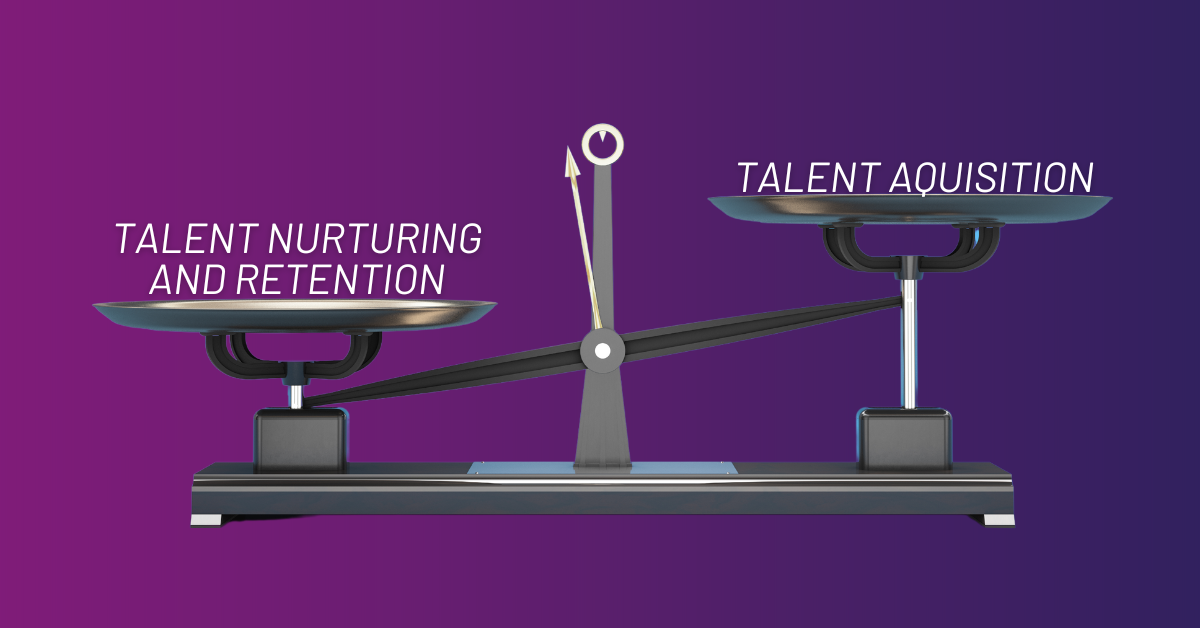If only the bad guy in ‘Indiana Jones and the Last Crusade’ had known that he need not drink from the Holy Grail to have a lasting impact on the world. This fact would no doubt have saved him from his rapid deterioration into a vaguely humanoid pile of ash upon selecting the wrong chalice, which – instead of granting life – took it away. Sucks to be him, I guess.
Now, hold on, because we’re going to run with this analogy. Turning to business, let us imagine two magical chalices: drinking from the wrong cup can render an organisation doomed to fail, while the other leads to long-term success. One of them allows an organisation to ‘buy’ talent (i.e. hire talented staff, or “talent acquisition”), while drinking from the other means that the organisation can ‘make’ it (i.e. develop talented staff internally, or “talent nurturing”) [1]. From which chalice should the organisation sip for long-term success in the modern world?

Follow along to understand how and why Word Monster has chosen the second chalice.
The old way of talent acquisition
First, let’s wind it back a couple of years. When Frodo was still drinking mead in the Shire, before the first Lord of the Rings hit cinemas in the early 00’s, the practice of external hiring was in the midst of a revival in the business world [1].
Businesses at the time were “drawing on a large pool of laid off talent” [1] – which sounds like something Dracula would do if he had his HQ in Wall Street. However, the marching of time is inevitable (even for vampires); things began to change.
With continued growth of the economy, the recruitment market became more competitive and companies began to poach staff from their competitors, causing retention issues [1]. Like the dwarves of The Hobbit, it seems companies had delved too greedily and too deep. The talent pool had begun to run dry.
A shift into talent retention and nurturing

Today, the focus has shifted to the development of talented staff from within the organisation, as opposed to hiring talent externally – a changing goal that is reflected in results from surveys [1,2]. A report by Dr Emma Parry from Cranfield University found that 78% of employers believed that internal development of employees had greater benefit to the organisation than external recruitment, with cost effectiveness being cited as a major benefit [1].
Furthermore, it is now widely agreed that talent is the “primary driver of any successful company”, playing a greater role in determining success than it ever has previously [1–4]. One article by Joely Carey of HuffPost sums it up rather nicely: “Any business is only ever as good as the people within it” [1]. Does anyone need to tell that to management in the Death Star?
Nurture your talent to victory
What are the consequences of failing to nurture talented employees from within? Returning to our Indiana Jones analogy, drinking from the recruitment chalice too deeply and neglecting internal development is likely to lead to failure in the long run – it will sap your business’ lifeforce.
Dr Parry’s research concluded that the most successful organisations tend to be those with a long-term focus on employee development [1]. So, if you take away one nugget of forbidden knowledge today, here it is: nurturing talent internally is vital. It’s the key to business immortality.
OK, so what exactly is ‘nurturing talent’? this means offering development opportunities for employees that are aligned with business goals, and the process can include:[1,2]
- Training and coaching
- Mentoring (like our Monster Academy)
- ‘Stretching’ employees with new responsibilities and tasks
- Keeping your employees engaged
Notably, a limited use of training is seen as a common weakness for businesses – one that may be particularly rife in small companies [5]. Do you have a formal training process in place? If the answer is no, now could be the time to change this – and prepare your business for long-term success. With the demand for skilled medical writers set to soar, it’s time to invest in building and upskilling your team. Whatever level your writers are at, we offer bespoke training and mentoring programmes through Monster Academy. We can build custom-made programmes built around the needs of your team. Just get in touch to learn more.
Conclusion
So, take our advice: treat your employees, be they associates or core team members, like the samurai treated Tom Cruise in The Last Samurai (no, we don’t mean kidnap them): train them to become experts in your company culture and skillsets. If you focus on developing your medical writing team, before you know it, you’ll be well on your way to achieving business immortality.
References
- Nurturing Talent: A research report. Available at: https://dspace.lib.cranfield.ac.uk/bitstream/handle/1826/3578/?sequence=1. Accessed February 2024.
- Why Nurturing Talent Is the Key to A Successful Business. Available at: https://www.huffingtonpost.co.uk/entry/why-nurturing-talent-is-the-key-to-a-successful-business_uk_5b757b84e4b0df9b093cdc79. Accessed February 2024.
- Chowdhary S. Nurturing Talent – To Create a Sustainable Advantage. Mediterranean Journal of Social Sciences. 2012;3(5):129.
- Beheshtifar M, et al. Effective Talent Management: A Vital Strategy to Organizational Success. International Journal of Academic Research in Business and Social Sciences. 2012;2(12):227–234.
- Simpson M, et al. Small business success factors: the role of education and training. Education + Training. 2004;46(8/9):481–491.
